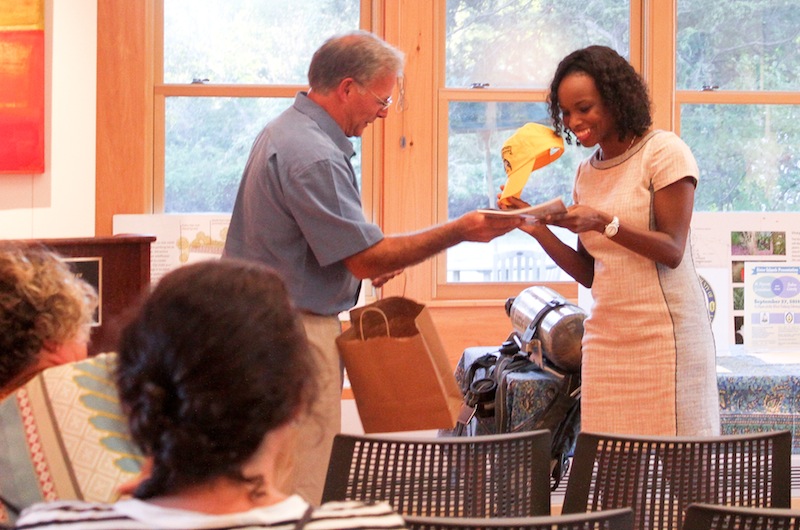Martha’s Vineyard and Saint Vincent and the Grenadines officially became Sister Islands this weekend, formalizing a relationship between the two islands that stretches back to the 19th century.
Saint Vincent and the Grenadines ambassador LaCelia Prince and Dukes County manager Martina Thornton signed a memorandum of understanding during a ceremony held Saturday afternoon at the West Tisbury Public Library. Several members of the Vineyard community also gave short presentations on topics ranging from education to fisheries.
“I have to say I am so happy to be here,” Ambassador Prince said to the audience, adding that from the minute she had stepped on the propeller plane in Boston, she had felt at home.
The Sister Islands initiative has been in the works for several months, and was first brought to the table by West Tisbury resident Anita Botti. Ms. Botti is a former director of the Peace Corps, and served as chief of staff for former Secretary of State Hillary Clinton’s Office of Global Women’s Issues. She was also a Peace Corps volunteer in the town of Calliaqua in Saint Vincent, an experience that left a deep impression on Ms. Botti.
“I always think of Calliaqua when I go to Menemsha, because it was that kind of town,” Ms. Botti said in her introductory remarks Saturday.
And Saint Vincent was again on Ms. Botti’s mind last year, after the island nation suffered a devastating rash of fires. While meeting with United States Ambassador to the Eastern Caribbean Larry Palmer and Ambassador Prince, the group brainstormed the idea of Sister Islands. Ambassador Palmer was active in the global Sister Cities project, which creates ties between similarly-sized cities across different continents.
Saint Vincent and the Grenadines is a cluster of 32 islands in the Caribbean, eight of which are inhabited. Saint Vincent is the largest and most populous. The country has a parliamentary democracy and a population of about 110,000.
Martha’s Vineyard and Saint Vincent first established a connection in the 19th century when whaling ships from the Vineyard and New Bedford sailed to the islands. Saint Vincent still has a small whaling industry today, with “roots grounded in culture,” Ambassador Prince said. The country has a quota of two whales per year.
The economy of Saint Vincent is, like the Vineyard, largely based on tourism. While the main island is a mountainous region, the smaller islands have little topography, making them more friendly to beachgoers. Ambassador Prince noted that Saint Vincent had been observing the effects of climate change, with erosion, coral bleaching, and unseasonable storms--including a particularly damaging one on Christmas Eve last year--more prevalent than ever before.
In Saint Vincent, there are six parishes, one hospital, and one airport that serves only local routes. A new international airport is expected to open next year, which Ambassador Prince said would help boost tourism to the region. Still, she said, the increase in tourism would be a challenge for Saint Vincent, which is still a largely pristine locale.
Representatives from the Vineyard have already lent input into the new airport’s construction. Last year, Chilmark executive secretary Tim Carroll and West Tisbury firefighter Glenn DeBlase traveled to Saint Vincent following the fires. Their goal was to offer an island perspective on how to better prevent and prepare for fires, but they also ended up offering insight into the airport blueprints.
Mr. Carroll and Mr. DeBlase both spoke about their experience during Saturday’s event. Their biggest takeaway, they said, was that Saint Vincent was in need of better protective gear for firefighters. When they returned to the Vineyard, they began to gather air packs that were still serviceable but not in use by Island fire departments.
Mr. Carroll said that on the final night in Saint Vincent he attended a talent show, where participants sang sailing songs he had heard in West Tisbury and Chilmark.
“I thought, wait a minute, where am I?” he said.
“I feel very lucky to have been part of this whole process,” Mr. DeBlase said.
Ambassador Prince said the Sister Islands initiative “brings home to me the importance of people-to-people relationships.”
Before the memorandum was signed, Dukes County commissioner Leon Braithwaite read a letter from Dr. the Honorable Ralph Gonsalves, Prime Minister of Saint Vincent, and Ms. Thornton presented a citation from the Massachusetts State House, which was secured by representative Timothy Madden.
Presentations from Vineyarders followed. Dukes County emergency management coordinator Chuck Cotnoir touched on shared challenges islands face in times of need, adding that since the Sister Islands project began, he had started tracking hurricanes in the Saint Vincent area as well as in the Northeast. Chamber of Commerce director Nancy Gardella, West Tisbury library director Beth Kramer, Martha’s Vineyard Museum development director Dan Waters, and Vineyard farmer and conservationist Bob Woodruff also spoke.
Schools superintendent James Weiss suggested future electronic pen pal projects and eventual staff and student exchange visits.
“When you talked about people-to-people--we are in the people business,” Dr. Weiss said.
Chuck Hodgkinson, a former chairman of the Martha’s Vineyard Striped Bass and Bluefish Derby, also brought home the importance of establishing relationships, citing the role of mutual aid in the 2010 Menemsha boathouse fire. Mr. Hodgkinson also discussed the roles of the commercial and recreational fishing industries on the Island.
He then presented Ambassador Prince with a bright yellow Derby hat.
“Welcome to our family,” Mr. Hodgkinson said.







Comments (4)
Comments
Comment policy »